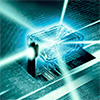| May 09, 2025 |
A method for fixing errors that occur in quantum computers is made massively more efficient through deep learning.
|
|
(Nanowerk News) A way to greatly enhance the efficiency of a method for correcting errors in quantum computers has been realized by theoretical physicists at RIKEN (Physical Review Letters, “Neural-network-based design of approximate Gottesman-Kitaev-Preskill code”). This advance could help to develop larger, more reliable quantum computers based on light.
|
|
Quantum computers are looming large on the horizon, promising to revolutionize computing within the next decade or so.
|
|
“Quantum computers have the potential to solve problems beyond the capabilities of today’s most powerful supercomputers,” notes Franco Nori of the RIKEN Center for Quantum Computing (RQC).
|
|
But some major hurdles need to be overcome before quantum computers can be used to tackle practical problems. In particular, ensuring that they perform calculations reliably is a critical issue.
|
|
“The reliability of quantum computers is constrained by their extreme sensitivity to the environment,” explains Nori. “Even minor environmental disturbances can corrupt quantum information.”
|
|
To unleash the potential of quantum computers, it is thus vital to develop techniques that can fix quantum errors.
|
|
One attractive method is the Gottesman–Kitaev–Preskill (GKP) code. Named after its inventors, the GKP code was proposed in 2001 as a way to encode a qubit, the quantum equivalent of a bit, in a harmonic oscillator—a system that resembles a pendulum.
|
|
“It’s a promising candidate to realize quantum error correction without requiring a lot of hardware,” says Nori.
|
|
However, GKP codes rely on squeezed states—quantum states that are difficult to generate and control. Consequently, GKP codes have been challenging to implement in practical experiments, particularly in light-based systems.
|
|
To overcome this problem, a team including Nori, Clemens Gneiting and Yexiong Zeng, both also at RQC, has developed a method that uses deep learning to optimize GKP states.
|
|
This optimization reduces the need to use large-amplitude squeezed states while preserving the code’s powerful error-correction capabilities.
|
|
“By leveraging AI, our method fine-tunes the structure of GKP states, striking an optimal balance between resource efficiency and error resilience,” says Zeng. “Our optimized GKP codes outperform conventional ones, requiring only a fraction of the squeezed states while achieving superior error correction.”
|
|
The method turned out to be remarkably efficient, exceeding the team’s expectations. “We were pleasantly surprised,” says Zeng. “The neural network achieved a much more efficient encoding than we had initially expected.”
|
|
“By reducing resource demands and improving error resilience, our work accelerates the path toward scalable, fault-tolerant quantum computing, paving the way for significant advancements in science and technology,” says Gneiting.
|
|
The team is now planning to extend the code to a multi-logical system, says Zeng.
|

